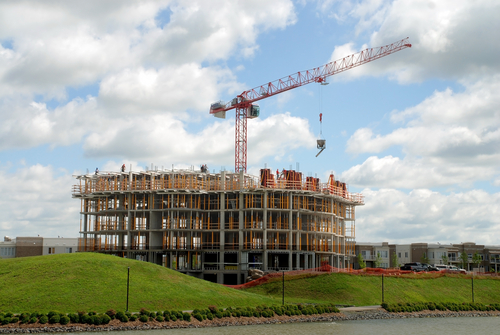The building has been planned carefully as an eco-friendly model. Careful attention to detail in selecting building materials was paramount. The heating and air conditioning was not only environmentally sound but the ventilation system had been thoroughly tested on a scale model for maximum design efficiency. Selection of the location was precise for orientation, natural landscaping, and minimal impact.

There are good reasons for such meticulous detail. Numerous studies show that across the lifetime of the building, when considering tenancy, energy costs, worker productivity, such attention to detail is more economical in the long run.
Even though many may say global warming and worldwide environmental concerns should be at the top of a green buyer’s list for sustainable architecture, the building infrastructure’s trend toward sustainable processes does not move that quickly. Regardless of the increased pace toward environmentally sound residential and commercial construction, large parts of the old-style building infrastructure will still dominate the landscape for the next 100 years at least.
There are things can be done now to help during the transition:
More emphasis needs to be placed on environmentally sound improvements on current structures. Though difficult if not impossible to completely retrofit most designs into old structures any expansions, improvements or repairs can be done with an eye towards sustainability. Everything from paints to wall and floor coverings that are upgraded on a semi-regular basis to heating, plumbing, and electric as needed can help shift the paradigm. This would not only cause overall positive effects to come about faster but would add the economies of scale to production of sustainable resources.
A second valuable byproduct of such incremental change would be in the retraining of the construction companies and personnel in newer more modern methods. This may encourage the use not only of environmentally sound buildings, but building techniques on the most fundamental level. Perhaps then when they broke ground on new buildings and renovations it would not be with old equipment bellowing black diesel carbon fumes and using three times the needed energy to run power tools. A shift in attitude at this lowest level of the building chain would push change faster than possible to legislate. Aside from the health benefits to the labourers on the construction site these labourers will one day be the foremen of small companies selling jobs and their bids and job recommendations would further change attitudes of all.
Along the same vein of thought, companies making construction equipment to do the construction work would add emphasis on this aspect of change. In fact, large companies such as JCB are fully aware of their duty to make their plant machinery more environmentally sound and recognise that to ignore this may lead to the demise of their business. The Scott JCB Digger has numerous variations including the brand new 3CX-ECO with increased fuel efficiency in all aspects of its functionality.
So, what we really need to consider when designing and constructing green buildings is not only the actual design itself but also where we source the raw materials, and also consider the people we hire and machinery used to create it, if we truly want to refer to it as a ‘green building’.
Author: Andrew Gough who is a prolific blogger in a wide range of niches.
Photo: Crane & new construction from Shutterstock
[source: http://feeds.importantmedia.org/~r/IM-greenbuildingelements/~3/0zY4xN8f8pE/]

Leave a Reply
You must be logged in to post a comment.